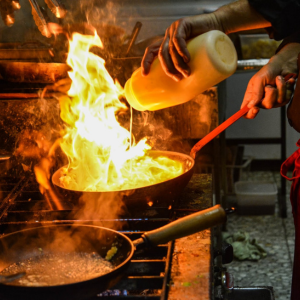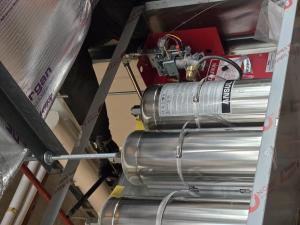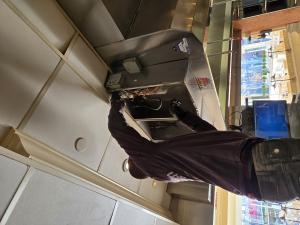Grease, Fire & Compliance: What Every Restaurant Owner Should Know About Kitchen Hood Safety


A done right hood and fire safety technician installing a fire suppression system at a local restaurant.
Grease fires don’t care if your restaurant is a Manhattan bistro or a Miami grill every commercial kitchen faces the same danger lurking in its exhaust hood.
FORT LAUDERDALE, FL, UNITED STATES, August 11, 2025 /EINPresswire.com/ -- Grease fires don’t care if your restaurant is a Manhattan bistro or a Miami beachside grill every commercial kitchen faces the same hidden danger lurking in its exhaust hood. In a city kitchen or a beach café, the wrong combination of heat, grease, and neglect can turn a busy service into a dangerous blaze in seconds. With input from seasoned technicians at Filta Kleen and Done Right Hood & Fire Safety, we’ll break down what it takes to keep kitchens safe in New York City, Miami, Fort Lauderdale, and Palm Beach from commercial hood cleaning in New York to Miami hood cleaning and Fort Lauderdale hood cleaning, the proper steps for commercial hood system installation, and why fire suppression and Ansul system requirements are inseparable from your ventilation setup.The tone here is conversational maybe a touch wry, because kitchen veterans know there’s humor in the day-to-day grind but the underlying message is serious: fire safety in the kitchen is non-negotiable. Every restaurant kitchen produces grease. Sizzling bacon, crackling woks, fryers turning out baskets of golden fries all of it sends up vaporized oils that cling to hoods, ducts, and fans.
“That coating of grease is basically fuel just waiting for a spark,” says Sal Ferraro, a veteran hood cleaner at Filta Kleen in New York City. Ferraro has spent more than a decade scraping inches of hardened buildup from exhaust systems in everything from Midtown diners to upscale steakhouses.
“If you skip your hood cleaning, fuggedaboutit you’re asking for trouble. One little flame can turn into a five-alarm fire with all that grease,” Ferraro warns.
He’s not exaggerating. According to the National Fire Protection Association (NFPA), cooking is the leading cause of restaurant fires, accounting for nearly 60% of incidents. Grease buildup inside ventilation ducts can ignite and spread flames well beyond the cooking area. An uncleaned hood gives fire a direct path to race through the ductwork like a fuse, endangering your staff, guests, and building. Regular hood and duct cleaning is not just a matter of hygiene it’s a key fire prevention measure. NFPA 96, the national standard for commercial kitchen ventilation and fire protection, mandates routine cleaning of the entire exhaust system, from the canopy hood to the exhaust fan, to remove grease buildup.
How often? It depends on cooking volume and type:
High-volume, 24/7 operations like busy Manhattan burger joints or late-night Miami seafood kitchens should be cleaned quarterly.
Solid fuel cooking (wood or charcoal grills, common in BBQ spots) requires monthly cleaning.
Moderate-volume restaurants may stretch to semi-annual cleanings.
Many New York restaurants clean more often than the minimum, especially with the FDNY watching closely.
“Here in New York, commercial hood cleaning isn’t just about safety it’s the law,” says Amanda Lee, a fire safety inspector with Done Right Hood & Fire Safety. The FDNY requires certified professionals for hood cleanings, often every three months, and technicians must carry a Certificate of Fitness (W-64 or P-64). “You’ve got to have an FDNY-approved company scrub it to bare metal,” Lee explains. After each cleaning, a compliance sticker is posted on the hood for inspectors. Skip a scheduled service or use an unlicensed crew, and you risk fines or even a shutdown. “In NYC, they don’t mess around,” Lee says with a knowing smile.
South Florida fire authorities are equally serious. Restaurants in Miami and Fort Lauderdale from Cuban fry shops to oceanfront grills run long hours, and their hoods see heavy use. Local fire codes align with NFPA 96 via the Florida Fire Prevention Code, requiring regular cleanings by qualified technicians. “Don’t think the Sunshine State gives you a pass,” Lee adds. “The humidity and heat down there might even make grease stickier.” With year-round high-volume cooking, Miami hood cleaning and Fort Lauderdale hood cleaning schedules can match New York’s for frequency. Fire inspectors in Palm Beach and Broward counties enforce these rules, and insurers often reward proof of regular maintenance with lower premiums.
Beyond safety and compliance, clean hoods keep the kitchen more comfortable. A grease-choked exhaust means poor smoke removal and stifling heat. Chefs in Little Italy or South Beach alike will tell you: nothing ruins a shift like cooking in a haze of oily smoke. A clean exhaust improves airflow, removes odors, and keeps both staff and guests happier. “It’s a win-win,” Ferraro says. “You reduce fire risk and make the space nicer to work in. No grease is the goal.” If cleaning prevents disasters, installation builds the foundation for long-term safety. “A lot of folks think a hood is just a big metal box over the grill — slap it on and you’re done. If only it were that simple,” laughs Miguel Santos, Installation Manager at Filta Kleen.
From food trucks in Queens to luxury hotels in Palm Beach, Santos has seen it all. Getting commercial hood system installation right starts with:
Blueprints & Menu – The type of cooking and layout determine hood type, fan size, and duct route.
Permits & Codes – In NYC, that’s DOB and FDNY rules; in Florida, building departments require stamped engineering plans per NFPA 96.
Hood Type – Grease-producing appliances require a Type I hood with fire-resistant ductwork to the exterior.
The duct path should be as direct as possible; every bend is a grease trap and a fire risk. Old Manhattan buildings may require creative routing, while many Fort Lauderdale builds can go straight to a rooftop fan. Once the canopy is mounted, ducts are run and fireproofed, and the exhaust fan is installed with usually a rooftop upblast fan; a make-up air system is added to replace the air pulled out. A modern hood isn’t complete without fire suppression. During installation, technicians prepare the hood for an Ansul system or similar, drilling for nozzles and mounting detectors.
Many jurisdictions require fuel shutoffs tied to the suppression system. “We often coordinate ductwork guys and the Ansul techs on the same day,” Santos says. That way, the hood, duct, and suppression integrate seamlessly. Even with spotless hoods and ducts, fire can still break out. That’s when an Ansul or equivalent wet-chemical suppression system takes over. Nozzles in the hood and duct connect to a pressurized tank. Above the cooking line, fusible links or sensors detect extreme heat. When triggered, the system releases a potassium carbonate solution that turns burning grease into soapy foam, smothering the flames. At the same moment, it cuts gas and electricity to the cooking appliances. “The moment that system trips, it’s like an automatic firefighter in your kitchen,” says Priya Desai, lead technician at Done Right. “Boom the fire’s blanketed, gas line’s cut, and alarms are going. It all happens in seconds.”
Ansul system requirements — and similar codes for other brands — demand:
Certified installation per NFPA 17A and manufacturer specs.
Full nozzle coverage for appliances, hood plenum, and ducts.
A manual pull station 10–20 feet from the hood.
Fuel shutoff when the system activates.
Semiannual inspections by certified technicians.
In both NYC and Florida, inspectors check the service tag date (no more than six months old) and ensure systems are UL 300 compliant for modern high-temp oils. Neglecting maintenance isn’t just a violation it’s a gamble. “It’s like a parachute,” Desai says. “You might never need it, but when you do, it better work.” In New York City, FDNY rules go beyond NFPA 96: quarterly cleanings for most hoods, only FDNY-approved cleaners, and documented proof on-site. While in South Florida, the Florida Fire Prevention Code enforces NFPA standards, with local fire marshals inspecting annually (or more if issues are found). Climate and building styles add complexity, NYC retrofits in old buildings require extra duct fireproofing; Florida coastal locations must secure rooftop fans for hurricane resistance and watch for salt corrosion.
From commercial hood cleaning in New York to Miami hood cleaning, from a new commercial hood system installation to meeting every Ansul system requirement, one theme is constant: each element works with the others. Clean hoods make suppression systems more effective. Proper installation makes cleaning and maintenance easier. Fire suppression protects everything when all else fails. “It’s like a relay race,” Santos says. “Each part has to hand off to the next without dropping the baton.”
Whether your kitchen is in Midtown Manhattan or a Fort Lauderdale marina, fire safety in commercial kitchens is about vigilance and teamwork. Schedule your cleanings, keep your suppression system inspected, and work with certified pros who know your local codes. As Ferraro of Filta Kleen puts it: “If we’ve done our job right, nothing exciting happens and in this business, boring is good.”
Gabriel Jean
Safety Group Corp.
+1 347-445-4880
email us here
Visit us on social media:
LinkedIn
Instagram
Facebook
YouTube
Legal Disclaimer:
EIN Presswire provides this news content "as is" without warranty of any kind. We do not accept any responsibility or liability for the accuracy, content, images, videos, licenses, completeness, legality, or reliability of the information contained in this article. If you have any complaints or copyright issues related to this article, kindly contact the author above.



